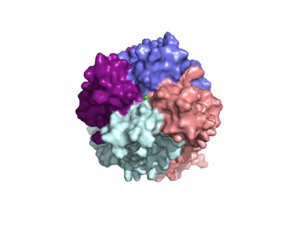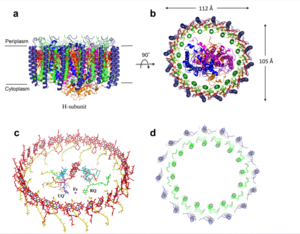Sandbox Reserved 1607
From Proteopedia
(Difference between revisions)
| Line 26: | Line 26: | ||
===Selectivity Filter=== | ===Selectivity Filter=== | ||
| - | The <scene name='83/832933/Selectivity_filter/2'>selectivity filter</scene> contains Glu358, Trp354, and Pro359 to allow calcium to pass through the uniporter. The carboxylate oxygen of the <scene name='83/832933/Glu_358/2'>Glu358</scene> side chains draw in the positive calcium ion. The diameter of the carboxyl ring is | + | The <scene name='83/832933/Selectivity_filter/2'>selectivity filter</scene> contains Glu358, Trp354, and Pro359 to allow calcium to pass through the uniporter. The carboxylate oxygen of the <scene name='83/832933/Glu_358/2'>Glu358</scene> side chains draw in the positive calcium ion. The <scene name='83/832933/Diameter/1'>diameter</scene> of the carboxyl ring is about 4Å, allowing only a dehydrated Ca ion to bind. Trp38, which is directly next to the Glu residues, stabilizes the carbonyl side chains through hydrogen bonding and anion pi interactions. These Trp residues also form stacking interactions with Pro359, which orientate the Glu carboxyl side chains towards the middle of the pore to interact with Ca ions. |
[http://www.rcsb.org/structure/6DT0 Calcium Uniporter Structure] | [http://www.rcsb.org/structure/6DT0 Calcium Uniporter Structure] | ||
Revision as of 02:15, 7 April 2020
Mitochondrial Calcium Uniporter
| |||||||||||
References
- ↑ Hanson, R. M., Prilusky, J., Renjian, Z., Nakane, T. and Sussman, J. L. (2013), JSmol and the Next-Generation Web-Based Representation of 3D Molecular Structure as Applied to Proteopedia. Isr. J. Chem., 53:207-216. doi:http://dx.doi.org/10.1002/ijch.201300024
- ↑ Herraez A. Biomolecules in the computer: Jmol to the rescue. Biochem Mol Biol Educ. 2006 Jul;34(4):255-61. doi: 10.1002/bmb.2006.494034042644. PMID:21638687 doi:10.1002/bmb.2006.494034042644
- ↑ Yoo J, Wu M, Yin Y, Herzik MA Jr, Lander GC, Lee SY. Cryo-EM structure of a mitochondrial calcium uniporter. Science. 2018 Jun 28. pii: science.aar4056. doi: 10.1126/science.aar4056. PMID:29954988 doi:http://dx.doi.org/10.1126/science.aar4056



